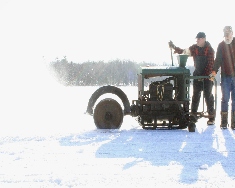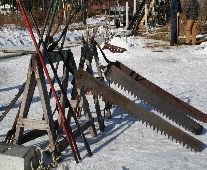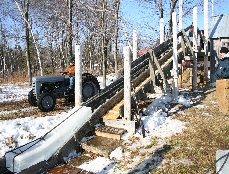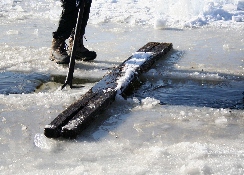|
|




Ice Harvesting: A Tradition Revisited- Erin Gurry |
In the 1800s many of the northern states were harvesting ice as a way to keep things cool throughout the year. In Pennsylvania the abundance of clean, unpolluted rivers, lakes and ponds made it an ideal location. Originally farmers found cutting and storing ice would bring in extra income and they sold the blocks to local residents, boardinghouses and hotels. As time went on, the business grew and farmers expanded their clientele. Soon ice was being harvested and then sent by rail to larger cities like Philadelphia and New York. A little research guided me toward the local festivals devoted to remembering this heritage of the land. Millpond #1, in a small town called Tobyhanna, is home to an annual ice harvest. The assembly is lead by some dedicated members of the society eager to introduce ice harvesting to new comers. Visitors are encouraged to take part and lend a hand in the cutting, floating, and packing of the ice. Only the skilled veterans of previous years are trusted with the task of cutting the main lines using the 1919 gas powered 36 inch saw blade. To begin the process, a sled with saws for runners is pulled from the edge of the pond toward a deeper section creating a channel through which the ice "cakes" will travel. The deeper pond water produces the more desirable ice as it tend to be clearer, more dense and with less air bubbles. It is here that the 1919 saw proceeds by scoring the main cut lines. Next, volunteers use the authentic hand saws to cut 21 x 21 inch cakes which are then maneuvered toward land through the channel. Between the ice house, used for storage, and the pond edge is a sturdy ramp. Volunteers use ice pikes, hooked metal poles, to gather three or four ice cakes together to begin their ascent up the ramp. Horse power, in this case a neighbor's Belgian horse, is then used to tow the ice blocks up the ramp where workers send them into the ice house. They are stored in a small, wooden building (most were whitewashed to reflect the sunlight). In earlier times the cakes were sometimes transferred to rail car, or in some cases barges, to await shipment to larger cities. The volunteers pack the ice in layers, with each layer receiving a plentiful covering of sawdust and straw for insulation. Behind the ice house a group of men tinker with an antique ice cream maker. Workers and spectators are welcome to try the ice cream as a sort of payment for their time. Volunteers are also permitted to use the ice throughout the year. They are encouraged to return next year to continue the ice harvesting tradition that helped shape early Pennsylvania tourism and commerce. |
Copia Magazine Home --- Contact Us --- Privacy Policy --- Copyright |